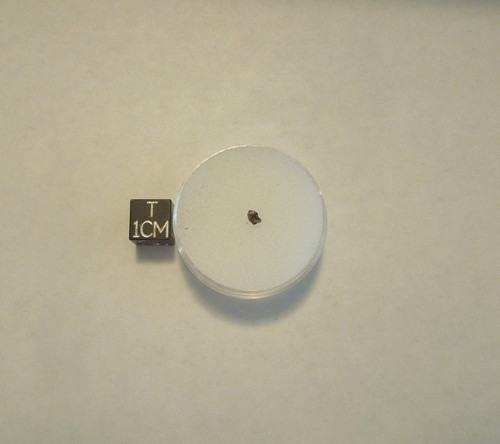On December 20, 2020, a bright fireball lit up the sky over a remote area of the western Algerian Sahara. Within a few days, the first meteorites were recovered by local hunters. Due to the dangerous military situation on the ground in Algeria, it took over a year for samples to find their way to labs for analysis.
At first glance, the meteorites looked like typical freshly-fallen H chondrites. But, upon cutting and closer examination, sizeable purple halide crystals were found inside the matrix. This is only the third known meteorite to contain extra-terrestrial salt (Zag and Monahans being the other two). The official classification is "H5, anomalous" - one of only 5 known to exist. Due to a lack of proper documentation for the recovery, this fall was officially classified as a "find, possible fall", but it is undoubtedly a "witnessed fall".
The specimen offered here is a small part slice that weighs approx. .044g (44mg).
Refer to the photo. The black centimeter cube is shown for scale and is not included. You are purchasing the specimen shown. Your purchase will include a labeled gemjar for safe storage.
From the Meteoritical Bulletin entry on SEH 001 :
Sidi El Habib 001 (SEH 001) 24.298°N, 3.745°W
Bordj Badji Mokhtar, Algeria
Find, possible fall: 2020 Dec
Classification: Ordinary chondrite (H5, anomalous)
History: On December 20, 2020, a bright fireball was witnessed in western Algeria by people prospecting for additional material of the Erg Chech 002 meteorite. After searching for two days a group of fresh fusion crusted stones was found at a location close to the Mali border at 24.298°N, 3.745°E and near a well named Hassi el Kounti. All of the collected material was purchased by Ben Hoefnagels in May 2021 from two Moroccan dealers.
Physical characteristics: Fresh fusion crusted stones with broad and shallow regmaglypts. Largest stone is 1.1 kg. Broken surface shows light-colored clasts in a matrix of light grey material. This grey material contains relatively abundant, to 1-mm, bright blue to purple grains of halite. Density of a 34 g stone comprising the two lithologies is 3.77 g/cm3, determined by the glass bead method. Magnetic susceptibility log χ (× 10-9 m3/kg) = 5.17.
Petrography: (L. Garvie, ASU) A sawn and polished 8 × 6 cm slice shows subhedral light-colored clasts, to 2 cm, in a light-grey matrix. Purple to blue crystals are locally abundant in the light-grey matrix: a powder XRD pattern of these crystals is dominated by reflections for halite and minor sylvite. Well-formed, though sparse, chondrules scattered through-out the clast and matrix lithologies, 601±403 micron (n=26), and separated by coarse-grained mineral and chondrule fragments. Chondrules dominated by PO, rare BO, and rare RP. Some unusual chondrule types present including one dominated by olivine-feldspar-chromite in the matrix lithology, and several Na-Al-Si-rich chondrules in the light-colored clast. Element mapping shows the NaCl to be present only in the grey-matrix lithology at all spatial scales from the mm-sized grains to sub-μm inter-grain films. The halite and sylvite are anhedral, though internally show well-developed cubic cleavage, and give the appearance of euhedral grains. A typical 4 × 4-mm-sized area of the halite-rich matrix contains ~8 areal% NaCl. High-resolution BSE images of the matrix show local regions with bright intergranular "veins" that are rich in Fe-Ni-Cl with little to no Na. A 1-mm subhedral ferroan sphalerite with a rim of troilite occurs in one of the probe mounts from the matrix lithology. The grain contains ~23 wt% Fe, close to the composition for rudashevskyite. Examination of the hand specimens shows several ferroan sphalerite grains in the matrix lithology: XRD of one of the grains confirms the sphalerite structure. Interchondrule feldspar is variable in size, though typically 5 to 20 μm. Merrillite and apatite are common in the clasts as grains to 0.5 mm (total 0.2 areal%). Some merrillite grains have veins and mantles of apatite. Element mapping of the light-colored clast shows several Cl hot-spots that are rich in Fe and Ni, but lack Na. Apatite and merrillite grains are more sparse and smaller in the matrix material.
Classification: H5 (breccia, anomalous). The pervasive presence of primary alkali halides in this meteorite is anomalous, and previously recognized only in Zag and Monahans (1998).





